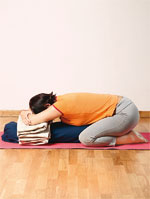Women should correct their yoga practice during the period. This is
something what you always hear in your yoga class. The reasons are pretty
obvious.
During their period women loose a lot of iron and energy even if we don’t
have any symptoms as PMS, stress and pain.
Ladies, let’s take care about our bodies, here you can find some
must-have postures during this time in our lives.
Corp Pose (Sanskrit Savasana)
Everybody knows this posture very well. Guidance through this posture
will follow up a bit later. Usually this one is final posture for your yoga
practice, but during your period I would recommend to start with Corp Pose and
breathe in your body, feel it before you will start active practice.
Child pose (Sanskrit Balasana)
Sit on your heels, spread your knees a little bit. Slowly move down to
the mat until your forehead will reach the floor. Position for your arms could
be different, you can extend them forward and use you Downward Facing Dog arms
or you can move them backward and just relax. The main point here is to relax
your pelvis on heels and relax abdominal area, which should be in connection
with inner thighs. In case if your buttocks are not on the heels, take a
blanket between.
Bound Angle Pose (Sanskrit Baddha Konasana)
Sit on your sitting bones and extend your legs, bend your knees and
bring your heels closer to your pelvis, then drop your knees out to the sides
and press the soles of feet together. Try to move your feet as close to pelvis
as it is comfortable for your body. In case if your knees are not on the mat
yet, take two blankets, roll them and use under your knees, bolsters will be
very useful here.
As a variation to reach more relaxation in this posture, try the
variation called Supta Baddha Konasana.
Prepare two bolsters and when you’re already sitting in Bound Angle Pose
place first bolster approximately under your floating ribs and use second
bolster for your head, lay down and relax.
Bridge Pose (Sanskrit Setu Bandha Sarvangasana) only with props
Prepare your base. Place first bolster under your spine, and place
second bolster under your feet. Lay down on first bolster, move backward until
your shoulders will meet the floor, as in Shoulder stand, and extend your legs
to meet second bolster. Relax and breathe.
Hero Pose (Sanskrit Virasana) only with props
Prepare your props. Place one bolster on your mat and place one or two blankets on the top. Sit on the floor close to bolster and lay down forward. Relax your
abdominal and your pelvis.
To avoid:
- Any inversions and
“legs up” postures
- Deep close twists
- Postures, which
compress abdominals (as Boat pose)
- Extreme backbends
(especially if these postures are not your favorites)
Keep your practice patient and calm, listen to your body and enjoy.




















